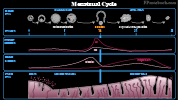Serum Progesterone
- Physiology
- Images
- Background
- Steroid Hormone secreted by the corpus luteum of the ovary
- Synthesis
- Follows LH (Luteinizing Hormone) Surge, starting the Luteal Phase (Secretory Phase)
- Progesterone is also synthesized in the Adrenal Gland and brain of both males and females
- Function
- Progesterone contributes to Breast development
- Progesterone primarily affects duct and alveolar bud development
- Estrogen is the primary Hormone in Breast development
- Progesterone prepares the endometrium for a fertilized egg (post-ovulatory, secretory phase)
- When the egg is not fertilized, Progesterone levels fall, and the endometrium is sloughed
- Progesterone contributes to Breast development
- Synthetics
- Progesterones are used in many contraceptives (e.g. Oral Contraceptives, mini pill, IUD, Depo Provera, Implanon)
- Progestins inhibit Ovulation
- Progestins thicken Cervical Mucus, preventing sperm from reaching the ovum
- Synthetic Progestins have Endometrial Activity, but also androgenic, Estrogenic and anti-Estrogenic Activity
- Progesterones are used in many contraceptives (e.g. Oral Contraceptives, mini pill, IUD, Depo Provera, Implanon)
- Interpretation
- Normal Male Levels
- Serum Progesterone < 1.0 ng/ml
- Interpretation
- Normal Female Serum Progesterone Levels
- Follicular Phase: 0.1 to 0.8 ng/ml
- Luteal Phase: 8 to 33 ng/ml
- First Trimester Pregnancy: 15 to 50 ng/ml
- Second Trimester Pregnancy: 43 to 179 ng/ml
